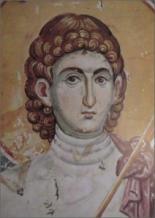The book Manuel Panselinos is written in French by Andrea Xyngopoulos. The drawings and sketches are by Photis Zachariou.

His most important work can be found in the Protaton church in Karyes (also see posts 393, 394, 663, 785 and 786 en 787).
His work is part of the Macedonian School.
I found this text on the internet about the Macedonian School:
The Macedonian School had its centre in Thessaloniki and flourished in the 13th and 14th centuries. Its hallmarks are realism in the depiction of the figures, not only in their external features but also in the rendering of their inner world, particularly their pathos. The compositions are crowded, with all the figures moving in the space, which is extensive and rendered in striking depth.

St Theodore Stratelates, Karyes, Protaton. Fresco by Manuel Panselinos, 14th c.
Painters from Thessaloniki were invited to paint Athonite foundations, and they frescoed the Protaton, the katholika of the Great Lavra, Vatopedi, Chelandari, and Pantokrator, and the refectory and cemetery church of Pantokrator. There were many famous ateliers of the Macedonian School, but head and shoulders above the rest stood the atelier of Manuel Panselinos.
All our information about Panselinos come from the Painter’s Manual, which was written in the early 18th century by an ordained monk and painter named Dionysios, a native of Fourna in Evrytania who lived on Mount Athos in the first half of the 18th century. Dionysios attributed to Manuel Panselinos the frescoes in the Protaton at Karyes, in the outer narthex of the katholikon of Vatopedi, and in the katholika of Pantokrator and the Great Lavra, and a large number of portable icons in monasteries on Mount Athos and elsewhere.


Sts Merkourios and Arsenios, Karyes, Protaton. Fresco by Manuel Panselinos, 14th c.
Scientific research has shown a number of paintings on Athos to be genuine works of Manuel Panselinos: the frescoes in the Protaton and the outer narthex of the katholikon of Vatopedi, a head of St Nicholas in the katholikon of the Great Lavra (the rest of the composition has been retouched), a portable icon of St Demetrios in the Great Lavra, and two icons of St Demetrios and St George in Vatopedi. Works of his have been located in monuments in Thessaloniki and other cities in Macedonia. Manuel’s frescoes are distinctive for their luminous colours, the consummate rendering of the figures, their welling spirituality, and the grandeur of the compositions.

Drawing from the central nave of the Protaton by Photis Zachariou
Apart from Manuel Panselinos paintings, works of the Macedonian School may also be admired in Chelandari Monastery, where the entire katholikon was frescoed by the renowned atelier of Michael Astrapas and Eutychios.
The characteristics of the Macedonian School remained apparent in all the frescoes and portable icons on Mount Athos until the beginning of the 16th century, when there was a gradual decline in the quality of the painting. Examples include the frescoes in the Chapel of St John the Baptist in the Protaton, which were painted in 1526. Wim, 4/6



Just a technical note 🙂
In it’s essence, fresco or fresco painting is an – application of natural mineral pigments to a surface on which a following chemical reaction takes place:
Ca(OH)2(s) + CO2(g) —-> CaCO3(s) + H2O(l)
Calcium Hydrate (burned lime stone or marble mií with water) combined with carbon dioxide resulting in the formation of Calcium Carbonate – lime stone, marble. The pigment gets trapped within the newly formed calcite crystal. It is like “Painting with molten Marbleâ€.
Very interesting, thank you.